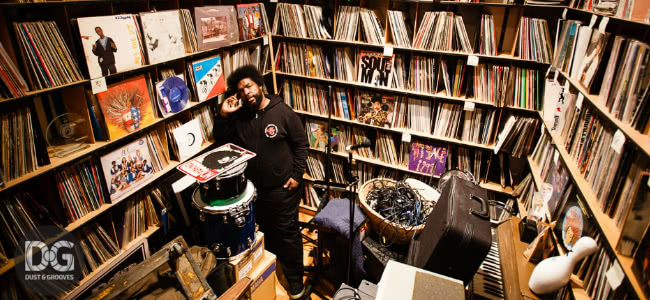You’ve read about the vinyl resurgence and maybe even been inspired to buy a vinyl record or two for yourself. Maybe you have a friend who’s deep into it and has gone out and re-purchased his entire music collection on wax in the hopes of scoring some hipster points.
Well, to some, vinyl is a lot more than a passing fad. In fact, it’s a lifestyle. Just ask Eilon Paz, a New York-based Israeli photographer who’s been documenting ardent record collectors since 2008 and has now compiled his favourites in a new book, Dust & Grooves, after his blog of the same name.
As The Guardian, who recently spoke to Eilon, notes, the photographer’s subjects aren’t bandwagon-jumpers or casual hobbyists. They obsess over ultra-rare Afropop 45s from the ’70s and hard-to-find pressings with mistakes on the cover that can only be found in Asia or Europe.
Some, like Gilles Peterson, try to take a more targeted approach in their collecting, but end up with 30,000 records in their possession regardless. Others, meanwhile, are steadfast completists who will purchase entire back catalogues of bands or labels without a single thought.
[include_post id=”436296″]
“I like to have music on vinyl, but I don’t need to have specific records. I’m just a music lover really,” Eilon tells The Guardian, contrary to most of his subjects. A Tel Aviv native, Eilon moved to New York in 2008, just as the recession was taking over.
Out of work, Eilon started hanging out in local record shops, immersing himself in the city’s vinyl scene. The seed for Dust & Grooves was planted when he photographed the owner of Tropicalia in Furs — an East Village record shop, now defunct — picking out rarities and oddities for the camera.
“It was just a fun personal project for me,” he says. “I didn’t really think about it as a book or even a proper website. Then the blog started generating a lot of reaction from the community – collectors were really excited to see other people’s collections. So what started out as a photography project evolved into a cultural exploration.”
Thought he began with a focus on younger vinyl lovers, many of whom were DJs, producers, or label heads, Eilon began photographing veterans like Joe Bussard, who boasts a legendary stash of early blues and gospel 78s, as well as collectors with no connection to the music industry – truck drivers, socialites, recluses.
[include_post id=”435497″]
The response from collectors was mostly enthusiastic. “Working on these features, you get bombarded with information,” Eilon says. “So I made a rule to pick only one record [to track down] and only one learning experience from each collector.”
Back in November, Eilon was invited to spend some time (an hour, to be specific) with Roots drummer and hip-hop icon Ahmir “Questlove” Thompson, who invited them into his vinyl library and highlighted some choice cuts, including the LP that “singlehandedly changed my life”.
For Eilon, a collector’s commitment to their collections makes perfect sense. “I asked [musician Joey Altruda] why he collects and he showed me a record that was given to him by his grandfather. That same record he’s going to give to his son. This is something you cannot do with digital music.”
“Of course you can move an MP3 around but it has no essence, you can’t really hold it. Vinyl records, like physical books, you can give them away, cherish them, pass them along. A record can move through generations. It’s a whole different experience. This really means something in people’s lives.”




































